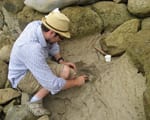
National Geographic reporter Jane J. Lee covered the research of SMU Earth Sciences doctoral student Ricardo Araújo, “Dinosaur Eggs Are Missing Link In Egg Evolution.”
Araujo published new findings in his scientific paper published May 30 in the journal Nature, “Filling the gaps of dinosaur eggshell phylogeny: Late Jurassic Theropod clutch with embryos from Portugal.”
Araújo describes a nest of 150-million-year-old dinosaur eggs discovered in Portugal, considered to be the first eggs and embryonic material of the Jurassic’s gigantic megalosaurid theropod Torvosaurus.
EXCERPT:
By Jane J. Lee
National Geographic
Studying dinosaur eggs is a lot like a big, frustrating Easter egg hunt: The eggs are rare, fragile—rainwater is acidic enough to dissolve some egg fossils—and it can be difficult to identify which dinosaur species they belong to.But every now and then, scientists’ persistence pays off. A recently discovered clutch of 150-million-year-old fossil eggs is being billed as an important missing link in the evolution of dinosaur eggs.
The find from the Late Jurassic period, described in a paper published May 30 in the journal Scientific Reports, gives scientists a picture of early dinosaur eggs and embryos from a group called theropods, which include Tyrannosaurus rex and modern birds.
“Most of the time, you find eggs without the embryos, or the embryos without the eggs,” said said Ricardo Araújo, a vertebrate paleontologist at Southern Methodist University in Dallas, Texas and lead author of the new study.
This is the first real picture of what early eggs in theropods might have looked like, said Robert Reisz, a vertebrate paleontologist at the University of of Toronto, who was not involved in the study.
The find will enable researchers to begin to address questions like which aspects of theropod eggshells came from their ancestors, and which ones evolved independently. (Learn more about dinosaur eggs.)
Gaps in The Record
Much of the fossilIzed egg material that scientists have found up till now belongs to the theropods, and dates to the Cretaceous period—about 80 million years ago. There are older dinosaur eggs from the Early Jurassic, or about 190 million years ago, but they belong to a sister group of dinosaurs called the sauropods. (Learn about the life of sauropods.)“There’s a real gap in the record for theropod dinosaur eggs and nests,” wrote Matthew Carrano, a vertebrate paleontologist at Smithsonian’s Natural History Museum, in an email this week. “We have very little from anything outside Coelurosauria, the group that includes birds.”
Follow SMUResearch.com on Twitter.
For more information, www.smuresearch.com.
SMU is a nationally ranked private university in Dallas founded 100 years ago. Today, SMU enrolls nearly 11,000 students who benefit from the academic opportunities and international reach of seven degree-granting schools. For more information see www.smu.edu.
SMU has an uplink facility located on campus for live TV, radio, or online interviews. To speak with an SMU expert or book an SMU guest in the studio, call SMU News & Communications at 214-768-7650.

 To book a live or taped interview with Ricardo Araújo in the SMU
To book a live or taped interview with Ricardo Araújo in the SMU  Study: High-volume Bitcoin exchanges less likely to fail, but more likely to suffer breach
Study: High-volume Bitcoin exchanges less likely to fail, but more likely to suffer breach Musicians who learn a new melody demonstrate enhanced skill after a night’s sleep
Musicians who learn a new melody demonstrate enhanced skill after a night’s sleep Study finds that newlyweds who are satisfied with marriage are more likely to gain weight
Study finds that newlyweds who are satisfied with marriage are more likely to gain weight